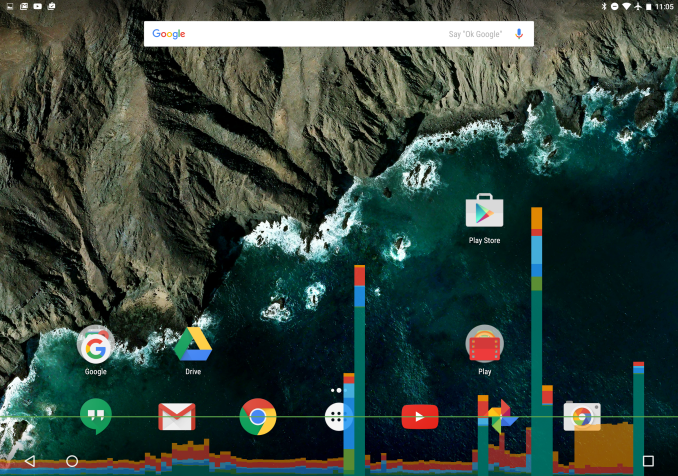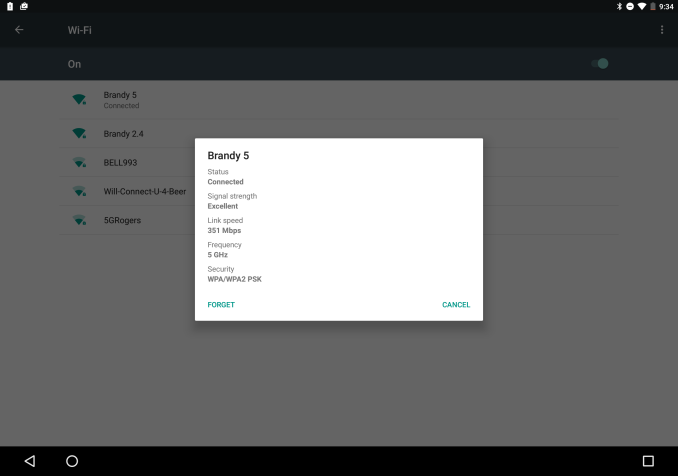Revisiting The Google Pixel C - Better, But Not There Yet
by Brandon Chester on February 17, 2016 8:01 AM ESTFinal Words
After taking in this new information, I suppose that the final question is whether or not my original verdict about the Pixel C still stands. That's a complicated question to answer, as the update from Google has addressed many, but not all of the issues I experienced with the original. I suppose it's worth doing a recap of what has and hasn't changed before deciding if this changes things for the Pixel C.
The most significant improvement with the updated firmware from Google is the fix for broken touch input. I really cannot overstate just how broken touch is on the Pixel C with its original shipping firmware, and the updated version feels like a completely different device. It's honestly like moving from a resistive touch display to a modern capacitive touch display, and even then, one could argue that resistive touch displays only had some of the problems that the Pixel C initially had. I think it's safe to say that this issue with the Pixel C is completely resolved, and that's a huge step toward making it a tablet that is worthy of commanding its $500 price.
The Pixel C drops fewer frames now than on the original firmware
On top of the fixes to touch input, the new software build has addressed a number of problems relating to performance and stability. I'm no longer experiencing frequent app and OS crashes, and in general there's far fewer stutters and slowdowns throughout the UI. Unfortunately, things aren't perfect. I still can't run our GPU battery test, which is really disappointing for Tegra X1's mobile debut. PCMark's battery test doesn't work for me either, even with the public version from Google Play. The test runs for some period of time, but eventually crashes, and I simply can't keep running it in the hopes that one run will eventually make it through. There are also a lot of applications that are just janky, including Google's Calendar app, and of course the eternally problematic Google Play and Google Chrome.
Chrome in particular is really bad regarding responsiveness and latency, and as far as web browsing goes it honestly feels like going back to something like an iPad 2 after the past five years of iOS updates have taken their toll on its responsiveness and performance. I have a feeling that Google is well aware of Chrome's problems, and I'm hopeful that they're something we'll see addressed in the near future, but for now you're really not getting the web browsing experience that a $500 device should provide.
As far as connectivity goes, I haven't seen improvements to the problems I experienced, which is disappointing. While I never had issues keeping connected with my home WiFi, the speeds and reception haven't been very good. I'm unable to maintain a signal at any appreciable distance, even when other smaller devices keep connected. Google tells me that poor antenna performance on 2.4GHz networks is a known issue, but 2.4GHz should be used as a fallback for when 5GHz can't provide sufficient range so that defeats the purpose entirely. Both Josh and I have also run into situations where the link rate drops below 400Mbps even when right beside the router, which is less than half of what it should be for a 2x2 802.11ac device.
In the end, Google's fixes to the Pixel C's software have done a lot to address the issues I noted in the original review. Its gone from being a tablet that I could not possibly recommend to anyone, to potentially being the best Android tablet you can buy. Unfortunately that's not a high bar to clear, but it's still a great improvement over the Pixel C with its original firmware. I still think I would forgo the keyboard, as Android just doesn't work well with it, and there aren't nearly enough tablet-focused applications to use it with to justify the additional cost.
I'm still reluctant to recommend high priced Android tablets due to the application situation, along with continued issues relating to input latency, multitasking, and gestures. However, if you really need something running Android then the Pixel C is an obvious option to consider. At the very least, the Pixel C is greatly improved with its new firmware. Once that happens I'll feel comfortable recommending the Pixel C provided you're okay with Android's general lack of tablet apps, and that's something that I certainly couldn't have said before.












67 Comments
View All Comments
polygon_21 - Wednesday, February 17, 2016 - link
Very very disappointing from GoogleImSpartacus - Wednesday, February 17, 2016 - link
Yeah, I feel like there's a story behind this that we might never get to truly learn. Very odd.parzival - Wednesday, February 17, 2016 - link
Try checking this out.http://arstechnica.com/gadgets/2015/12/the-pixel-c...
CurbedLarry - Wednesday, February 17, 2016 - link
Google is behaving like the US auto industry in the 70sWe're number 1, we can put out any old trash and people will still buy it
kurkosdr - Monday, March 21, 2016 - link
Or was it Nvidia? Most of the bugs seem driver-related. Stay away from any Android device featuring a Nvidia SoC. Nvidia chips almost killed LG. You 've been warned. Fortunately there aren't many Nvidia-powered devices them around, but Google still wants to throw them a bone once in a while to shake the Qualdroid stigma inthe hi-end segment, so you occasionally see an Nvidia chip shoved in a Nexus/Pixel tablet. Always the last Nexus to get updates or doesn't get them correctlypsychobriggsy - Wednesday, February 17, 2016 - link
Google needs to learn that sometimes you just need to can a product, even if it's 90% complete and otherwise quite nice. Android is just a shitty tablet OS.jabber - Wednesday, February 17, 2016 - link
Either that or you just put the release back another couple of months to get it 99% right rather than 75%. People will wait for a finished/fully working product.xthetenth - Wednesday, February 17, 2016 - link
That goes double or triple for a tablet that puts that much of its weight budget into and focuses so hard on its keyboard. The only OS that would make sense with that hardware is W10 (after a nub mouse was added). Even iOS is coming at it from a different direction that would make a hypothetical iPixel C a conflicted mess. An OS that's limited to tablets as oversized phones and a keyboard that's more than a sixth or so the overall weight of the device can not work together and should not be tried. For reference it's more biased towards the keyboard than the Surface line, and those run a full desktop OS.Honestly this and the OS in general is making me sad again that Android has done well.
xenol - Wednesday, February 17, 2016 - link
Well the good thing about Android is it's open source and free software. So some people went out of their way of creating a more proper desktop based OS that fits this formfactor: http://www.jide.com/en/remixosxthetenth - Wednesday, February 17, 2016 - link
That would be a good bit closer to right, and I'd consider the device with that, although I'd likely want W10.